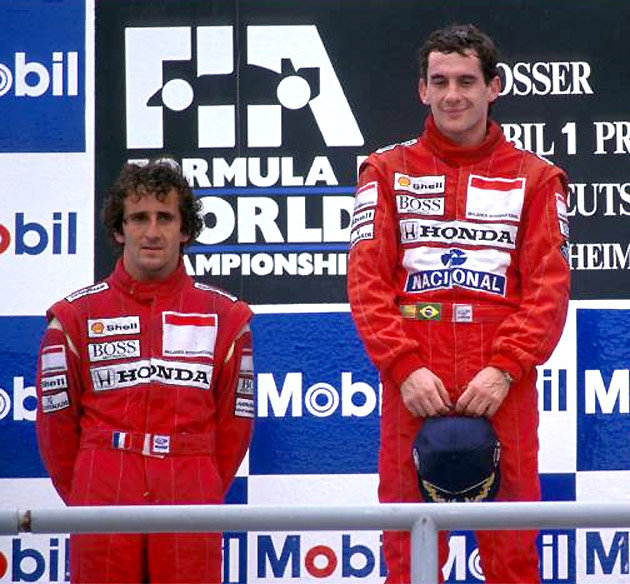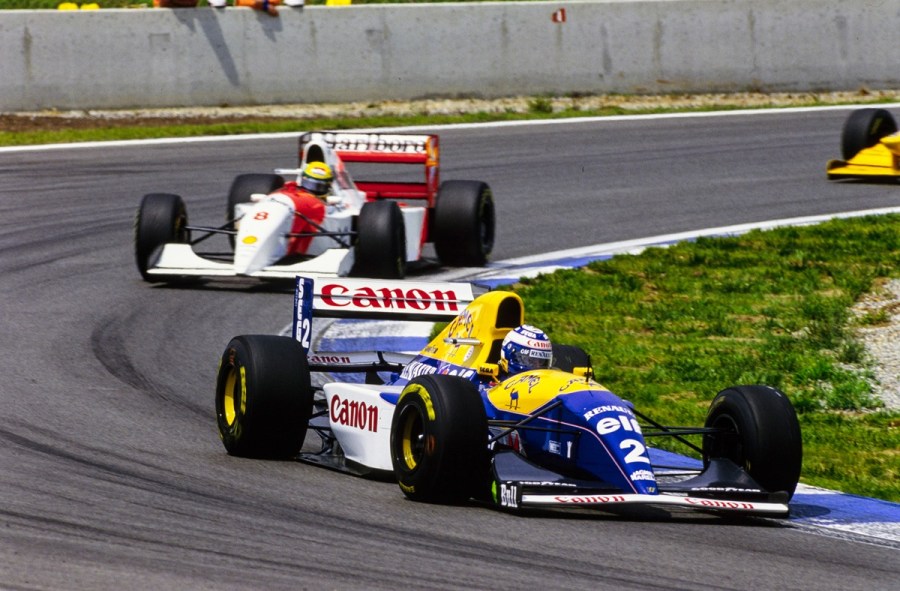Prost vs Senna is one of the greatest rivalries to ever happen in motorsport. So, grab some popcorn as we tell the full story.
Separated by a five-year age gap and entirely different cultural backgrounds, Alain Prost and Ayrton Senna were two very different people – but both ferocious competitors. In hindsight, perhaps it should’ve been obvious that pitching the pair of them against each other (often in the same garage) would result in fireworks. But, it didn’t start out that way.
Although they had both held places on the F1 grid throughout the early-to-mid eighties, the story really begins in 1988. Fresh off the back of a successful stint with Lotus, Senna graduated to the McLaren Formula One team, which at the time was the crew to beat. Replacing Stefan Johansson, he took up the role of Alain Prost’s teammate; the Frenchman having won the F1 World Driver’s Championship the previous year. However, Senna proved to be a much closer match for Prost than Johansson ever was.
The pair of them traded victories throughout 1988, culminating in what would turn out to be a rather foreshadowing showdown in Japan. Heading into that race at Suzuka, a win would see Senna dethrone Prost as king of F1, but a dodgy start meant he was faced with an uphill battle. After dropping down to as far as 14th, Senna miraculously climbed his way back up through the order, even managing to hunt down Prost and re-pass him. With that, Senna claimed his first F1 driver’s world championship title at Prost’s expense, but this would barely be a footnote in the story that was yet to come…

Teammates turn sour
Although the battle had been hard-fought, Prost and Senna remained relatively amicable throughout the 1988 season. However, that all changed in 1989.
Imola was the venue where the spark would be ignited. Behind the scenes, McLaren had come to the agreement that whoever was first to make it to turn one would be allowed to cruise to victory without threat from their teammate. And, given the dominance that McLaren had over the other teams at the time, they knew that nobody else would be a factor either. To an outsider, it all sounds tremendously unsporting, but I guess this was just another example of Ron Dennis’ hard-nosed management style. Unfortunately, when you have two drivers as competitive as Prost and Senna, such an agreement was never going to be a good idea.
A deal gone wrong
At the start of the race, Senna converted pole position into the race lead as the pack of cars headed into turn one. And, as requested, Prost kept in line without offering much in the way of a challenge. Not too long later though, Gerhard Berger suffered a massive accident in his Ferrari, which burst into flames. Fortunately, Berger would get away from the incident with ‘just’ a set of bruised ribs and second degree burns. Nevertheless, the race was halted under red flag conditions so that the medics could extract the Austrian from his car.
On the restart, things went down a little differently at the head of the field. This time, Prost beat Senna off the line and led into turn one, but then Senna retook the lead of the race further around the lap. In his mind, this didn’t breach McLaren’s prior agreement, as he had already ‘earned’ the win by leading before the race had been temporarily halted. Prost, however, did not see it the same way, suggesting that the opportunity for ‘earning’ the victory should have been reset after the red flag period. This was the first real sign of tension between the two sides of the McLaren garage; tension which would bubble away and evolve into something much greater as the year went on.
Two Suzuka showdowns

1989
Just like in 1988, the pair were pretty evenly matched throughout the 1989 season, resulting in a winner-takes-all scenario in Japan yet again. Senna had to win to defend his title, and although Prost was leading in the latter stages of the race, the Brazilian was reeling him in. Eventually, Senna launched his car into an overtaking move at the chicane, which was the penultimate corner of the lap – just in view of the massive grandstand along the start-finish straight.
Diving down the inside, Senna quickly found that the gap he had gone into was closing rapidly. Approaching the corner, Prost turned in as per usual, as if he either hadn’t seen Senna – or simply didn’t care that he was there. A cynic might call it calculated. The result was, inevitably, contact between the two of them.
Prost retired on the spot, but Senna wouldn’t give up. The marshals managed to bump start his McLaren, and after a quick trip to the pit lane, Senna was back out onto the circuit. Due to the dominant speed of the ’89 McLaren, the only real barrier to victory for Senna was Alessandro Nannini’s Benetton, which he dispatched with relatively easily. Indeed, Senna would go on to win the race, but that still wasn’t enough. Hours after the checkered flag had fallen, the FIA governing body disqualified him for that bump start he got off the marshals – a move deemed illegal.
So, in the end, the title would go to Prost. After the event, Senna reiterated his intent to always fight until the very end, meanwhile Prost – who was headed out the McLaren exit door for Ferrari – said, “to be very honest, I’m quite happy to leave because it becomes absolutely impossible to work with Ayrton.”
1990
As was now becoming tradition, the 1990 Japanese Grand Prix at Suzuka once again promised a title showdown between Prost and Senna, this time with the added flavor of them competing for different teams. On this occasion though, the tables were turned. Instead, it was Prost who was coming from behind in the points standings. Just like Senna in the previous year, Prost knew that he needed to win the race to keep his championship hopes alive.
Before the green flag had even been waved though, controversy was brewing. Having won pole position, Senna was irked by the fact that the leading grid slot was on the less grippy side of the grid. As Prost had qualified second, but would therefore start on the grippier side of the circuit, Senna felt hard-done by and attempted to get the sides of the starting positions reversed. Naturally though, this was rejected.
Anyway, either through emotion or genuine lack of grip, Senna made a worse start than Prost, handing the Ferrari driver the lead as the cars headed towards turn one. That lead didn’t last long however, as Senna flung his McLaren into a gap that was always going to close. The result was a heavy contact between the front of Senna’s McLaren and the rear-quarter of Prost’s Ferrari, sending them both spectacularly off into the gravel trap, and out of the race. As neither of them would score any points, the championship would therefore go to Senna. In the aftermath, Senna would utter his now-famous quote, “If you no longer go for a gap that exists, you are no longer a racing driver.”
However, while that may have been his public defense, it’s easy to view this incident as one of revenge for the ’89 crash that favored Prost.

Into the ’90s
In 1991, Prost found himself stuck with a Ferrari that was barely up to winning races, let alone championships. As a result, the Prost-Senna rivalry lay dormant for much of the year as Senna strolled to a third championship title with McLaren. There was one particular flashpoint for the pair of them though.
At the German Grand Prix, Senna and Prost were battling away for fourth place. Prost tried a move on the outside, but Senna held his line, meaning Prost locked up and went out onto the run-off area at the chicane. The Frenchman then had to wait for a marshal to remove a cone from his path so that he could rejoin the circuit, only to stall his Ferrari, and promptly retire. From the outside, the coming together looked fairly innocuous, but Prost was furious with Senna. In response, Senna replied “I think everyone knows Prost by now… there’s always somebody else to blame, it’s never his fault.”
Ferrari sacked Prost at the end of 1991, but after a sabbatical in 1992, the veteran made his way back to the F1 paddock for 1993. And, in doing so, he would re-ignite the bad blood he shared with Senna. After much speculation, Prost eventually signed for Williams. However, due to the changing tides of dominance between the teams, Senna had also been interested in signing for the British outfit. At least, that was until that it emerged that Prost had negotiated a veto against the team signing Senna as his teammate. In the press, Senna brandished his rival a “coward” for not wanting the fight.

A happy ending?
Prost’s comeback ended up being a farewell tour, with the 1993 Adelaide Grand Prix turning out to be his final ever F1 race as a driver. A stellar year behind the wheel earned him his fourth championship title, with Senna ending the year as runner-up in a slightly inferior McLaren.
Although Prost had won the war in 1993, Senna took the honor of winning the final race. During the podium ceremony, the Brazilian invited Prost to join him on the top step as a mark of respect. So, despite everything that had happened between the pair, even up until that very same year, it became apparent that Senna had a willingness to end the feud.
In a future interview, Prost would reveal that, “he changed his way completely with me when we were on the podium in Adelaide. A few days later, he called me, and that kept going throughout the winter. So, yes, in this way, he’s a friend.”
Senna would of course go on to replace the retired Prost at Williams for the 1994 season, during which he would tragically lose his life at Imola, the circuit where this titanic rivalry began. In that context, the amends made between the pair before Senna’s death seem even more poignant.
All in all, Prost vs Senna was one of the greatest rivalries that motorsport has ever seen; one that flared up often and sometimes brought the sport into disrepute, but ultimately burned out into a beautiful sense of respect. Keep an eye out for the second entry into my Motorsport Legends series next week.








